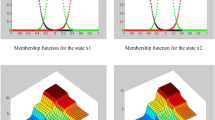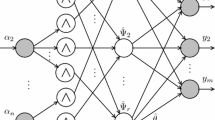Abstract
This paper develops a smooth model identification and self-learning strategy for dynamic systems taking into account possible parameter variations and uncertainties. We have tried to solve the problem such that the model follows the changes and variations in the system on a continuous and smooth surface. Running the model to adaptively gain the optimum values of the parameters on a smooth surface would facilitate further improvements in the application of other derivative based optimization control algorithms such as MPC or robust control algorithms to achieve a combined modeling-control scheme. Compared to the earlier works on the smooth fuzzy modeling structures, we could reach a desired trade-off between the model optimality and the computational load. The proposed method has been evaluated on a test problem as well as the non-linear dynamic of a chemical process.










Similar content being viewed by others
References
Salehfar, H., Bengiamin, N., Huang, J.: A systematic approach to linguistic fuzzy modeling based on input-output data. In: Proceedings of the 2000 winter simulation conference (2000)
Peeva, K., Kyosev, Y.: Fuzzy relational calculus: theory, applications and software. Advances in fuzzy systems-applications and theory, vol. 22. World Scientific Publishing Co., Pte. Ltd., Singapore (2004)
Campello, R.J.G.B., Amaral, W.C.: Modeling and linguistic knowledge extraction from systems using fuzzy relational models. Fuzzy Sets Syst. 121, 113–126 (2001)
Kreinovich, V., Nguyen, H.T., Yam, Y.: Fuzzy systems are universal approximators for a smooth function and its derivatives. Int. J. Intell. Syst. 15(6), 565–574 (1999)
Sadjadi, N., Herrero, J., Molina, J., Hatami, Z.: On the approximation properties of smooth fuzzy models. Int. J. Fuzzy Syst. (2018). https://doi.org/10.1007/s40815-018-0500-9
Babuska, R.:, Fuzzy modeling and identification. Ph.D. Thesis, Delft University of Technology, Department of Electrical Engineering, Delft, The Netherlands (1997)
Wu, D., Mendel, J.M.: On the continuity of type-1 and interval type-2 fuzzy logic systems. IEEE Trans. Fuzzy Syst. 19(1), 179–192 (2011)
Courant, R., John, F.: Introduction to Calculus and Analysis, vol. II/1. Springer, New York (1999)
Šostak, A.P.: On a fuzzy topological structure (English). In: Frolík, Z., Souček, V., Vinárek, J. (eds.) Proceedings of the 13th winter school on abstract analysis. Section of Topology. Circolo Matematico di Palermo, Palermo, 89–103 (1985)
Ramadan, A.A., Abbas, S.E., Kim, Y.C.: Fuzzy irresolute mappings in smooth fuzzy topological spaces. J. Fuzzy Math. 9, 865–877 (2001)
Amudhambigai, B., Uma, M.K., Roja, E., Nadu, T.: m*-Fuzzy basically disconnected spaces in smooth fuzzy topological spaces. Mathematica Bohemica 138(1), 1–13 (2013)
Amudhambigai, B., Uma, M.K., Roja, E.: Pairwise r-Fuzzy b-Open sets in smooth fuzzy bitopological spaces. Int. J. Math. Sci. Appl. 2(2), 663–671 (2012)
Amudhambigai, B., Uma, M.K., Roja, E.: Separations axioms in smooth fuzzy topological spaces. Scientia Magna 5, 90–98 (2009)
Peeters, W.: Subspaces of smooth fuzzy topologies and initial smooth fuzzy structures. Fuzzy Sets Syst. 104, 423–433 (1999)
Sadjadi, E.N.: Discussion on accuracy of approximation with smooth fuzzy models, Under Review
Sadjadi, E.N.: Sufficient conditions for the stability of smooth fuzzy systems, Under Review
Sadjadi, E.N.: On the monotonicity of smooth fuzzy systems, Under Review
Kandiah, S.: Fuzzy model based predictive control of chemical processes. Ph.D. Thesis, University of Sheffield, Sheffield (1996)
Campello, R.J.G.B., Amaral, W.C.: Hierarchical fuzzy relational models: linguistic interpretation and universal approximation. IEEE Trans. Fuzzy Syst. 14(3), 446–453 (2006)
Castellano, G., Fanelli, A.M., Mencar, C.: A neuro-fuzzy network to generate human-understandable knowledge from data. Cogn. Syst. Res. J. 3(2), 125–144 (2002)
Zadeh, L.A.: Fuzzy Sets, Information and Control, vol. 8, pp. 338–353. Springer, Cham (1965)
Prakash, J., Srinivasan, K.: Design of Nonlinear PID Controller and Nonlinear Model Predictive Controller for a Continuous Stirred Tank Reactor. ISA Transactions, Elsevier, Amsterdam (2009)
Todorov, Y., Terzyiska, M., Petrov, M.: Recurrent Fuzzy-Neural Network with Fast Learning Algorithm for Predictive Control, Lecture Notes in Computer Science book series, M. Ladenov et al. (eds.), LNCS 8131, 459–466, Springer, New York (2013)
Fuller, R.: Fuzzy reasoning and fuzzy optimization: Turku Centre for Computer Science, available on line (1998)
Oviedo, E., Jairo, J., Vandewalle, J.P.L., Wertz, V.: Fuzzy Logic, Identification and Predictive Control. Springer, London (2005)
Sadjadi, E.N.: Structural properties of time varying smooth fuzzy models for identification, Under Review
Sadjadi, N., Herrero, J., Molina, J., Menhaj, M.B.: How effective are smooth compositions in predictive control of TS fuzzy models. Int J Fuzzy Syst. (2019). https://doi.org/10.1007/s40815-019-00676-0
Funding
This publication was supported in part by project MINECO, TEC2017-88048-C2-2-R.
Author information
Authors and Affiliations
Corresponding author
Ethics declarations
Conflict of interest
The authors declare that there exists no conflict of interest.
Ethical Approval
This article does not contain any studies with human participants or animals performed by any of the authors.
Rights and permissions
About this article
Cite this article
Sadjadi, E.N., Garcia, J., Molina Lopez, J.M. et al. Fuzzy Model Identification and Self Learning with Smooth Compositions. Int. J. Fuzzy Syst. 21, 2679–2693 (2019). https://doi.org/10.1007/s40815-019-00725-8
Received:
Revised:
Accepted:
Published:
Issue Date:
DOI: https://doi.org/10.1007/s40815-019-00725-8




